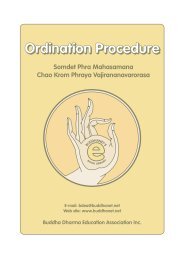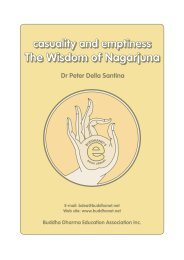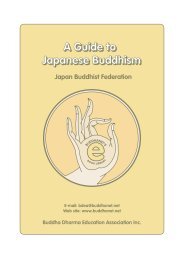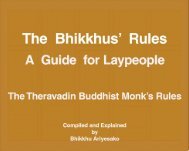No Inner Core: An Introduction to the Doctrine of Anatta - BuddhaNet
No Inner Core: An Introduction to the Doctrine of Anatta - BuddhaNet
No Inner Core: An Introduction to the Doctrine of Anatta - BuddhaNet
Create successful ePaper yourself
Turn your PDF publications into a flip-book with our unique Google optimized e-Paper software.
impermanent is dukkha. Dukkha means more than just<br />
painful. Dukkha also comes from our desire for permanence.<br />
Dukkha means difficult <strong>to</strong> bear mentally and<br />
physically, and thus we call <strong>the</strong> impermanence <strong>of</strong> all<br />
phenomena dukkha (suffering).<br />
In <strong>the</strong> third part <strong>of</strong> Buddha’s questioning, He asks,<br />
“Is that which is impermanent and painful fit <strong>to</strong> be<br />
called ‘mine, I, my self or soul?’” Buddha is here leading<br />
<strong>the</strong> monks <strong>to</strong> <strong>the</strong> discovery <strong>of</strong> anattà. Is something<br />
that is disappearing fit <strong>to</strong> be called atta? <strong>No</strong>. From anicca<br />
(impermanence) <strong>to</strong> dukkha (suffering), and finally <strong>to</strong><br />
anattà (no-soul) <strong>the</strong> monks are led.<br />
Let us review again <strong>the</strong> processes which hide impermanence,<br />
suffering, and no-soul. We, as unenlightened<br />
people, fail <strong>to</strong> see impermanence because we do<br />
not see <strong>the</strong> arising and disappearing <strong>of</strong> things. We are<br />
tricked by continuity, which hides <strong>the</strong> nature <strong>of</strong> impermanence.<br />
We look at things or at consciousness and see<br />
<strong>the</strong>m as continuous. In order <strong>to</strong> see impermanence, we<br />
must observe closely <strong>the</strong> arising and disappearing <strong>of</strong><br />
phenomena. We must penetrate, by means <strong>of</strong> concentration<br />
and insight developed in meditation, through<br />
<strong>the</strong> impression <strong>of</strong> continuity, which acts as a cover <strong>of</strong><br />
impermanence. Let us think <strong>of</strong> a ring <strong>of</strong> fire. Someone<br />
has a <strong>to</strong>rch and twirls it <strong>to</strong> create an impression <strong>of</strong> a<br />
circle <strong>of</strong> fire. But we know that <strong>the</strong>re is really no ring<br />
<strong>of</strong> fire; it is just <strong>the</strong> impressions <strong>of</strong> individual positions<br />
<strong>of</strong> <strong>the</strong> fire at different places and at different times. But<br />
our mind takes <strong>the</strong> impressions as something continuous;<br />
ra<strong>the</strong>r, our mind connects <strong>the</strong> impressions and we<br />
deceive ourselves.<br />
46
















